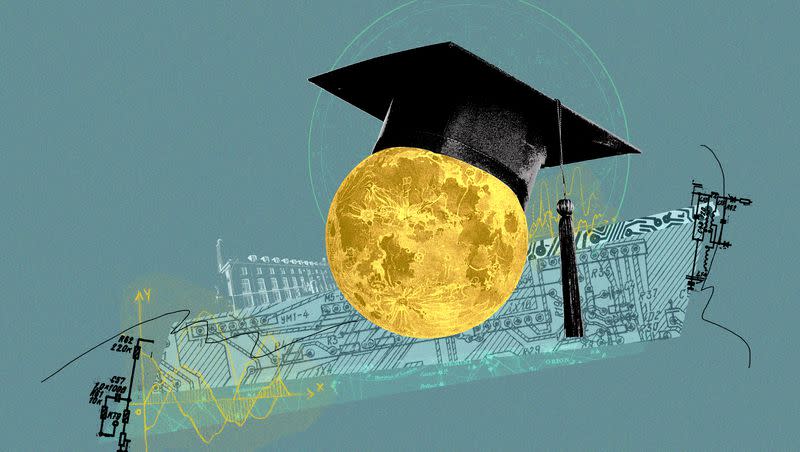The ‘momentum principles’ to completing college

Space is big. Really big. You just won’t believe how vastly, hugely, mind-bogglingly big it is. I mean, you may think that it is a long way down the road to the chemist, but that’s just peanuts when it comes to space.
So begins the “Hitchhiker’s Guide to the Galaxy.” The truth is that the sweeping scale of God’s creation really cannot fit into the scale of human consciousness in any meaningful sense. Yet, with austere brevity, the book of Genesis begins with God creating it all, at a word.
The grandeur of the first chapter of Genesis is exchanged in the second with a different mood. The scene changes just as if the director has put on their close-up lens, refocusing, not on the scale of planets and stars and super-novae, but to one single man and his Creator. The style of the language and the message of the text move to an astonishing intimacy. God, which only a few lines before had created on a breathtaking scale, now reaches down and carefully forms a man and breathes the breath of life into his body.
The universe of modern higher education is nowhere near as vast or complex. Yet there are lessons to be drawn from the Genesis story and the contrast between the two halves of its telling, as we think simultaneously at scale and individually about higher education transformation.
Despite increased college attendance rates in recent years, completion rates remain low, particularly for underrepresented and low-income students who often lack social support networks.
Over the last decade, I have led work that attempts to bring new understanding to what works in systems of higher education and, conversely, what does not; what barriers we have historically and often unknowingly placed in the way of our students’ success; and in what ways we might take their journey to new heights.
When I started, there was a firmly held mantra that the only way to improve graduation rates was to have better students. The fault for lack of college success once lay firmly on the students’ side.
A decade later, we now see how wrong-headed that thinking was. Indeed, it is now clear that much of the onus for college success lies in the structure of higher education itself, and that fundamental changes to that structure can unlock tremendous increases in the success of those self-same students that previous approaches have failed.
Implementation of what have come to be known as momentum strategies has produced significant improvements in student success in several state systems and closed equity gaps, especially for adult students, low-income students and students of color.
Related
The strategies that have been uncovered were all in response to chasms in student success outcomes, brought to light by detailed big-data-style data analysis. For instance, at the course level, a student’s success in the English and math courses required for their degree during the first year of college turns out to be crucial to graduation success. Students who complete credit-bearing courses in both subjects are not just a percentage point here or there more likely to graduate, but five to 10 times more likely than their colleagues who do not.
The unique relationship religious schools have with their students may offer opportunities to further amplify the core momentum principles. For instance, while students who struggle to persist in college often fail to identify an early academic purpose, religiously based schools might draw on a spiritual catalyst or mentoring relationship as a way to develop an early academic plan.
The BYU-Pathway program has connected momentum principles into its first-year curriculum. Not only do they teach college success skills such as notetaking, writing, math and planning, they teach students their divine potential as children of God. This sense of worth appears to elevate the learners’ belief in themselves and their potential to succeed, connecting their educational journey with their journey of faith.
It is important that, as we engage with the threads of higher education transformation at scale, our efforts are braided with the strands shaped by our students’ individual lives. We need to reflect and respect the diverse needs of students and ensure racial and socioeconomic equity.
We must find ways to provide comprehensive supports to overcome barriers that non-academic factors or resource gaps might otherwise create. And we should create a learning environment that enables students to find purpose and value in their academic studies, creating a sense of belonging.
I often say that we don’t graduate statistics. Instead, higher education is an experience that impacts the lives of individuals one by one. John Henry Newman, the 19th-century English theologian and academic, described a university as “an Alma Mater, knowing her children one by one, not a foundry, or a mint, or a treadmill.”
Even as we search for ways to implement the momentum strategies for all our students, we have to find a way to bridge the gulf between the abstraction of policy, practice, structure and curriculum, to the intimacy of implementing that work student by student. The students we serve come to us with unique life circumstances and challenges — with resource challenges and beliefs about themselves as learners. It is only by looking along, not at, the policies and structures that we put in place that we can appreciate how best to serve those students as individuals, and truly transform the learning journey that we create with them.
Tristian Denley is the deputy commissioner for Academic Affairs and Innovation at the Louisiana Board of Regents.
This story appears in the September issue of Deseret Magazine. Learn more about how to subscribe.

